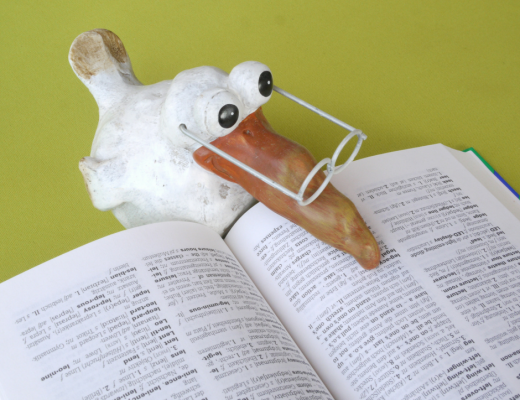*This article was originally written for Lee Lofland’s The Graveyard Shift. If you haven’t read his blog yet, check it out! Credit for the picture goes to Lee Lofland. Thank you!*
Finn found a pale blue T-shirt at the back of the closet that had a corny slogan only a math teacher would find funny. It had a beer can and the limit definition of the derivative on the front of it. On the back it said Never Drink and Derive.
Pretty clever, right? At least for a math pun. How well do you think this will translate into other languages? Not too well into German, considering that the German words for drive and derive are “fahren” and “ableiten.” There goes the pun.
I’m a translator, and I translate books from English into German. That excerpt comes straight from my desk (from Amy Harmon’s “Infinity + One”). Puns like this are part of the reason why translating is more than just looking up words in a dictionary and stringing them together. Translating a book into a foreign language requires careful adaptation to make sure the (in my case) German version has the same effect on the reader as the English original. Anything that could take readers out of the story because they have no idea what is meant has to be localized, with the utmost respect to author and story.
In order to do my job properly, I have to become invisible. Have you ever read a book that was not originally written in the language you are reading it in and thought: “Man, that translator did a great job”? Whenever the translator is mentioned in a review, it’s almost always because he or she did a poor job. So when reviewers write that the author’s style is fantastic, that the book was so much fun and very easy to read, that the puns were clever and the mystery suspenseful, I feel I’ve done both the book and the author justice.
When I started learning English at the age of fourteen, my teacher gave me some great advice: “Always assume that the sentence made sense before you tried to translate it.” That’s a pretty good guideline for a professional translator. It’s crucial to fully understand the original book. If I know something is supposed to be funny but I don’t get the joke, I must have missed something. The same applies to any references I don’t get. This is where translation becomes more than just looking up words; it’s about being knowledgeable about foreign traditions and cultural references.
If the text refers to cream tea, it helps to know this doesn’t in fact involve tea with cream but a traditional English meal where the tea is actually served with milk, but the scones come with clotted cream. If a character claims she seems to have moved to Mayberry, it helps to be familiar with the Andy Griffith Show. But what do you do if that show never aired in Germany, and your German readers will have no idea what the woman is referring to? You get creative. After spending weeks trying to come up with TV characters that would evoke the same image for the German reader as Barney Fife and Andy Taylor, I took a completely different approach by referring to two different tools, a sharp one and a not-so-sharp one. Mayberry became the toolbox. Footnote averted.
However, I try hard to keep the original setting very much alive in the story. If a private eye lives in Los Angeles, I won’t move him to Cologne to make it easier for German readers to relate to him and his surroundings. But if he talks a lot about taking Advil, I might change that to ibuprofen, since Advil is not available in Germany and is therefore unknown to German readers. By changing the brand name to the generic product, it becomes immediately clear that we’re talking about a painkiller (my pharmacist loves these consultation visits, by the way).
The German language works differently than the English language, and we even have different gestures. Putting somebody’s head between their knees will not immediately communicate to the reader that a person feels sick – it just seems like a strange thing to do. So you either explain it in a throwaway line, making sure it doesn’t take the reader out of the story, or find a gesture that’s familiar to Germans and conveys the same meaning. But you do need to make sure you’re not doing all the thinking and interpreting for the reader – show, don’t tell.
And then there’s the dreaded issue of “Sie” and “du.” The German language has two options for the English pronoun “you”: the formal “Sie” for people who have either just met or have a business relationship rather than a personal one, and the informal “du,” which is used for friends and family. When translating a book, you have to make a lot of decisions – how do the characters address each other to make it sound organic, and at what point do the protagonists switch from “Sie” to “du” (assuming they meet for the first time during the course of the story)? I once had to re-write an entire scene after finishing the book because in the end, it turned out that the hero and the cop who arrested him at the beginning were brothers. During the arrest, they had a conversation in front of witnesses. I couldn’t use the “Sie” form because family members wouldn’t address each other that formally, but didn’t want to use “du” either, to maintain the element of surprise until the end as the author intended. So I had to carefully craft a conversation that avoided all forms of address without sounding unnatural, so as not to alert the reader that something might be up with the two characters.
And this is exactly why I love my job. I love the challenge, and that I get to bring new stories to German readers.
I once read that submitting a book for translation is like sending a child to live abroad. But with your translator, there’s family abroad who will take care of your child and love it as if it were their own.






No Comments